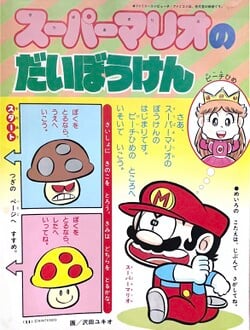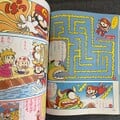Super Mario no Daibōken
The title of this article is official, but it comes from a Japanese source.
If an acceptable English name is found, then the article should be moved to the new title.
This article is about a work that used to be available to the public, but is now partially or entirely inaccessible. Details: a lot of scans unavailable
Our documentation of the subject is inadequate. Only remove this notice if the complete work is recovered and made available publicly.
| Super Mario no Daibōken | |
|---|---|
 The first page of December 1986 issue | |
| Artist | Yukio Sawada |
| Publisher | Shogakukan |
| Label | Yōchien |
| Original language | Japanese |
| Release date | |
| ← Previous Mario no Bōken Meiro |
Next → Ganbare Super Mario |
Super Mario no Daibōken is a puzzle series written and illustrated by Yukio Sawada based on Super Mario Bros.: The Lost Levels, in which the player makes their own choices to determine the story's outcome. It was published in the kindergarten-aimed magazine Yōchien (幼稚園) published by Shogakukan in December 1986 and in March 1987.
Content[edit]
December 1986[edit]
Mario has to reach Princess Peach.
- His first crossroad had the reader choosing between two mushrooms.
- Grabbing the Poison Mushroom causes Mario to become small. Next, he can either pick a route through a beanstalk or grab a Starman before entering a cloud maze.
- Climbing the beanstalk, Mario will end up in the upper part of the cloud maze with two dead ends: one with a Koopa Paratroopa, and one that will cause a Game Over due to the lack of an exit.
- Taking the Star, Mario goes to the lower part of the cloud maze, with one dead end with a Bullet Bill, and the exit. Taking the exit causes the invincibility to run out, and Mario bumps against a Goomba, getting a Game Over.
- Grabbing the Magic Mushroom transforms him into Super Mario, and he can either pick a Fire Flower or collect the coins. He then goes in a underwater maze.
- Choosing to collect the coins, their weight will lead Mario to the lower part of the maze, causing a Game Over when he reaches a dead end.
- With the Fire Flower, Mario can swim in the upper part of the maze, with two dead ends leading to a Bloober and a Cheep Cheep and the exit. With the use of fireballs, Mario makes it out of the maze unharmed and now has to decide who to fight: Bowser or a Hammer Brother.
- Choosing the Hammer Brother, Mario will succumb to his hammers, earning a Game Over.
- Selecting Bowser, Mario defeats it with his Fiery form and will access the final maze with multiple dead ends, one of which leads to a Piranha Plant. At the goal, Peach is waiting in a Mushroom House.
- Grabbing the Poison Mushroom causes Mario to become small. Next, he can either pick a route through a beanstalk or grab a Starman before entering a cloud maze.
January 1987[edit]
The story is based around the Japanese New Year.
February 1987[edit]
Mario, Peach and Toad are celebrating mamemaki, when Bowser appears and Mario start chasing him before he can ruin the festivity. Puzzles included are a connect-the-dots with Bowser's faces and two mazes infested by Bowser's Minions, culminating with Mario catching Bowser, and using him as the oni and the fireballs as the rice grains.
Gallery[edit]
Names in other languages[edit]
| Language | Name | Meaning | Notes |
|---|---|---|---|
| Japanese | スーパーマリオのだいぼうけん[3] Sūpā Mario no Daibōken |
Super Mario's Great Adventure |
References[edit]
- ^ "Published in Learning Kindergarten 1986 December issue" – @JaredHendrix6 (March 26, 2024). Confirmation from the collector (Post). Retrieved May 18th, 2025 from X.
- ^ "小学館の幼稚園 1987/3 ドラえもん フラッシュマン スーパーマリオの大ぼうけん ドラゴンボール がんばれ!キッカーズ ウルトラマン" ("Shogakukan Kindergarten 1987/3 Doraemon Flashman Super Mario's Big Adventure Dragon Ball Ganbare! Kickers Ultraman") – Former auction post of the issue in question (Auction post). Retrieved May 18th, 2025 from auctions.yahoo.co.jp.
- ^ File:SMND 1.jpg










